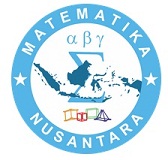KEMAMPUAN PEMECAHAN MASALAH MATEMATIS SISWA DALAM MENYELESAIKAN SOAL PISA MATEMATIKA PADA KONTEN BILANGAN
Abstract
Full Text:
PDFReferences
Andayani, F., & Lathifah, A. N. (2019). Analisis kemampuan pemecahan masalah siswa SMP dalam menyelesaikan soal pada materi aritmatika sosial. Jurnal Cendekia : Jurnal Pendidikan Matematika, 3(1), 1–10. https://doi.org/10.31004/cendekia.v3i1.78
Annizar, A. M., Maulyda, M. A., Khairunnisa, G. F., & Hijriani, L. (2020). Kemampuan pemecahan masalah matematis siswa dalam menyelesaikan soal pisa pada topik geometri. Jurnal Elemen, 6(1), 39–55. https://doi.org/10.29408/jel.v6i1.1688
Bidasari, F. (2017). Pengembangan soal matematika model PISA pada konten quantity untuk mengukur kemampuan pemecahan masalah matematika siswa Sekolah Menengah Pertama. Jurnal Gantang, II(1), 63–78. https://doi.org/10.31629/jg.v2i1.59
Hasibuan, S. A., Fauzi, K. M. A., & Mukhtar. (2020). Development of PISA Mathematical Problem Model on the Content of Change and Relationship to Measure Students Mathematical Problem-Solving Ability. International Electronic Journal of Mathematics Education, 15(2), 1–9. https://doi.org/10.29333/iejme/6274
Indahwati, T., Dafik, & Irvan, M. (2020). The development of Islamic-based PISA question models on the topics concerning quantity and its enhancement to improve student problem solving skills. Journal of Physics: Conference Series, 1563(1), 1–13. https://doi.org/10.1088/1742-6596/1563/1/012067
Johar, R. (2012). Domain soal PISA untuk literasi matematika. Jurnal Peluang, 1(1), 30–41. http://www.jurnal.unsyiah.ac.id/peluang/article/view/1296/1183
Juliana, Ekawati, D., & Basir, F. (2017). Deskripsi kemampuan pemecahan masalah matematika siswa dalam menyelesaikan soal sistem persamaan linear dua variabel. Pedagogy: Jurnal Pendidikan Matematika, 2(1), 121–133. https://doi.org/10.30605/pedagogy.v2i1.666
Mahardiningrum, A. S., & Ratu, N. (2018). Profil pemecahan masalah matematika siswa SMP Pangudi Luhur Salatiga ditinjau dari berpikir kritis. Mosharafa: Jurnal Pendidikan Matematika, 7(1), 75–84. https://doi.org/10.31980/mosharafa.v7i1.343
Mahmudah, W. (2018). Analisis kesalahan siswa dalam menyelesaikan soal matematika bertipe HOTS berdasar teori Newman. Jurnal UJMC, 4(1), 49–56. https://doi.org/10.52166/ujmc.v4i1.845
Miles, M. B., Huberman, A. M., & Saldaña, J. (2014). Qualitative data analysis: A methods sourcebook (3rd ed.). SAGE Publications, Inc.
NCTM. (2000). NCTM: Principles & standards for school mathematics (PSSM) est: 2000. In The National Council of Teachers of Mathematics, Inc. https://www.itws.org/NCTM-ContentProcessCoreStandards.pdf
OECD. (2014). PISA 2012 results: What students know and can do: Vol. I (Revised ed). OECD Publishing. https://doi.org/10.1787/9789264208780-en
OECD. (2019). PISA 2018 assesment and analytical framework. In OECD Publishing. OECD Publishing. https://doi.org/10.1787/b25efab8-en
Oktaviana, D. V., Syafrimen, S., & Putra, R. W. Y. (2018). Analisis kemampuan pemecahan masalah matematis siswa kelas IX MTs dalam menyelesaikan soal model PISA pada konten perubahan dan hubungan. JES-MAT (Jurnal Edukasi Dan Sains Matematika), 4(1), 47–56. https://doi.org/10.25134/jes-mat.v4i1.909
Polya, G. (2004). How to solve it: A new aspect of mathematical method with a new foreword by John H. Conway. Princeton University Press.
Rismen, S., Juwita, R., & Devinda, U. (2020). Profil kemampuan pemecahan masalah matematika siswa ditinjau dari gaya kognitif reflektif. Jurnal Cendekia: Jurnal Pendidikan Matematika, 04(01), 163–171. https://doi.org/10.31629/jg.v5i1.1579
Sari, N. M., Yaniawati, P., Darhim, & Kartasasmita, B. G. (2019). The effect of different ways in presenting teaching materials on students’ mathematical problem solving abilities. International Journal of Instruction, 12(4), 495–512. https://doi.org/10.29333/iji.2019.12432a
Setiawan, E., Muhammad, G. M., & Soeleman, M. (2021). Analisis kemampuan pemecahan masalah mahasiswa pada mata kuliah teori bilangan. Mosharafa: Jurnal Pendidikan Matematika, 10(1), 61–72. https://doi.org/10.31980/mosharafa.v10i1.735
Son, A. L., Darhim, & Fatimah, S. (2019). An analysis to student error of algebraic problem solving based on Polya and Newman theory. Journal of Physics: Conference Series, 1315(1), 1–7. https://doi.org/10.1088/1742-6596/1315/1/012069
Surya, E., Putri, F. A., & Mukhtar. (2017). Improving mathematical problem-solving ability and self-confidence of high school students through contextual learning model. Journal on Mathematics Education, 8(1), 85–94. https://doi.org/10.22342/jme.8.1.3324.85-94
Ulandari, L., Amry, Z., & Saragih, S. (2019). Development of learning materials based on realistic mathematics education approach to improve students’ mathematical problem solving ability and self-efficacy. International Electronic Journal of Mathematics Education, 14(2), 375–383. https://doi.org/10.29333/iejme/5721
Warmi, A. (2019). Pemahaman konsep matematis siswa kelas VIII pada materi lingkaran. Mosharafa: Jurnal Pendidikan Matematika, 8(2), 297–306. https://doi.org/10.31980/mosharafa.v8i2.384
Wijaya, A., Heuvel-Panhuizen, M. Van Den, Doorman, M., & Robitzsch, A. (2014). Difficulties in solving context-based PISA mathematics tasks: An analysis of students’ errors. The Mathematics Enthusiast, 11(3), 555–584. https://dspace.library.uu.nl/bitstream/handle/1874/306080/Wijaya_7.pdf
Yerizon, Putra, A. A., & Subhan, M. (2018). Student responses toward student worksheets based on discovery learning for students with intrapersonal and interpersonal intelligence. International Electronic Journal of Mathematics Education, 13(3), 97–101. https://doi.org/10.12973/iejme/2701
Yuristia, N., & Musdi, E. (2020). Analysis of early mathematical problem-solving ability in mathematics learning for Junior High School student. Journal of Physics: Conference Series, 1554(1), 1–4. https://doi.org/10.1088/1742-6596/1554/1/012026
Zain, M., Idris, M., & Rizal, M. (2016). Analisis pemecahan masalah aljabar siswa kelas VII SMP Negeri 3 Palu. Jurnal Elektronik Pendidikan Matematika Tadulako, 03(03), 358–372. https://jurnal.fkip.untad.ac.id/index.php/jpmt/article/view/293
DOI: http://dx.doi.org/10.30870/jppm.v15i1.14102
Refbacks
- There are currently no refbacks.
Copyright (c) 2022 JPPM (Jurnal Penelitian dan Pembelajaran Matematika)
Ciptaan disebarluaskan di bawah Lisensi Creative Commons Atribusi 4.0 Internasional .
JPPM (Jurnal Penelitian dan Pembelajaran Matematika). Jurnal ini diterbitkan oleh Jurusan Pendidikan Matematika FKIP Universitas Sultan Ageng Tirtayasa (cetak) dan Jurnal Untirta (eprint).
Alamat Penerbit: Jl. Raya Ciwaru No 25 Kota Serang Banten, Jurusan Pendidikan Matematika, Fakultas Keguruan dan Ilmu Pendidikan, Universitas Sultan Ageng Tirtayasa, Kampus Ciwaru, Serang, Banten, Indonesia. Telepon / Faks: (0254) 280330 Ext 111, Email: [email protected] |Klik untuk mengakses: Jurnal Penelitian dan Pembelajaran Matematika


